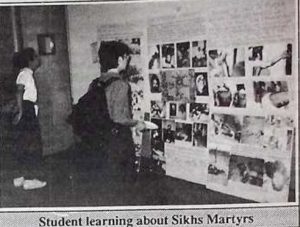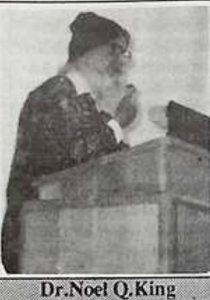
BERKELEY: On Tuesday, September29,1992, the Sikh Students Association of UC Berkeley held a film and lecture presentation titled “Who Are the Sikhs?” on the University of California at Berkeley campus. The program was organized as an educational event for the general public. Its purpose was to dispel stereotypes of Sikhs and shed light on the theological and historical background of the Sikh community. The program began with a short, 20-minute film called “Who Are the Sikhs?” which was produced and distributed by Sikhs Serving America in Kansas. The film covered basic issues in Sikhism such as the origins of the faith, the Gurus’ teachings, the 5 Ks and basic beliefs and way of life. This visual presentation was followed by two well-versed lecturers Dr. Noel Q. King, professor at the University of California at Santa Cruz, and Dr. Amarjit Singh, spokesperson for the Panthic Committee and a question and answer panel.
Dr.King, who was born in a village in former Punjab, is a Professor Emeritus of history and comparative religion at UC Santa Cruz, His topic for the evening was “Sikhism Origins and Beliefs,” in which he discussed basic tenets of Sikhism and structure of the Sikh community. He conveyed the meaning of the word “Sikh” as learner or disciple, and the vision of the Gurus that was laid down in the Guru Granth Sahib. Dr, King also introduced the rejection of the caste system that Sikhism is based on, explaining that to Sikhs, “all are the children of God.” He continued that Sikhs feel no need to “subjugate” or “dominate” as other groups have done because Sikhs believe in respect for all God’s creatures.
Dr.King also referred to the current crisis in Punjab and said that Sikhism has been “attacked since the beginning.” He added that the Sikh suffering is comparable to that of the Jews, if not more so due to the consistent persecution Sikhs have faced since the birth of their faith in 1469.
An interesting point Dr.King brought up was the Sikh contributions to the ideas of non-violence used in the Indian independence movement. According to Dr.King, Gandhi’s knowledge about civil disobedience paled in comparison to the Sikhs actual use of peaceful resistance. Sikhs gave “so much” for India’s freedom, Dr.King noted, and “now they are accused of being terrorists.”
Many in the audience felt Dr.King exuded the spirit of a trace Sikh in his lecture. Dr. Amarjit Singh said the audience could feel that spirit in Dr .King’s recitations of Gurbani.
Dr.Singh, who is also the Executive Director of the Khalistan Affairs Center, spoke on “Socio Political Aspects of Sikhism.” He gave a thorough analysis of the attitudes leading up to the current crisis in Punjab and the temporal and spiritual bond in Sikhism. He introduced the concept of political and religious unity by relating how Guru Nanak was fully aware of the social and political realities of his time, Dr.Singh explained that Guru Nanak confronted the Muslim Emperor Babar and told him what un-Islamic behavior he was exhibiting by persecuting people. It was through these basic ideas advocating the rights of all and believing in the equality of everyone under God that Guru Nanak revolutionized the thinking of his time.
Dr.Singh also related how the fundamentals of Brahmanism both in the Gurus’ times and today have led to persecution of the type that is going on in Punjab today. This system based on inequality, he explained, is entrenched in today’s Indian government.
Many members of the audience felt Dr. Amarjit Singh’s lecture opened their eyes to enormous problems they knew nothing about. UC Berkeley student Sonia Chawla said, “The second speaker (Dr.Singh) showed how people fail to acknowledge that all these problems exist. Sikhs are marginalized by society and the media and they have gone through hell. I didn’t realize how bad the situation was.” Chawla felt the overall presentation was “really informative.” After the two lecture presentations, there was a question and answer panel in which the audience asked the guest speakers questions ranging from how many Sikhs there are in the world to whether Khalistan offered a viable solution. Additionally, during the program, members of the Sikh Students Association set up literature about Sikhism and the Punjab crisis outside of the lecture hall for people to view. Boards were also set up depicting brutal scenes of torture of Sikhs. Many members of the audience took a look at the information after the program,
A member of the Sikh Students Association, Jasdeep Singh Alag, felt the program went a long way in educating the public about the Sikhs,
I got to talk to a lot of people outside who were curious about the picture boards the graphic pictures and Amnesty International photos. They were shocked.”
Overall, he said, “We spread the message of what’s going on.”
Funding was generously donated by the Fremont Gurdwara Sahib Committee and The Sikh Center, El Sobrante Gurdwara Sahib Committee, both of which are located in the Bay area.

Article extracted from this publication >> October 16, 1992